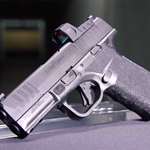
This article, "A Storm On Your Side: Beretta Px4 Storm," appeared originally in the September 2006 issue of American Rifleman. To subscribe to the magazine, visit the NRA membership page and select American Rifleman as your member magazine.
Keeping up with the Joneses is the order of the day with semi-automatic pistol makers in these troubled times. They work in a ferociously competitive market with rumors of big government contracts just over the horizon. Pistols are big business in the small-arms field, and the maker who prospers is the one who not only keeps up with Jones but actually gets ahead of him.
I cannot help but believe that getting ahead was part of the rationale for Beretta when it introduced this new semi-auto, and I was privileged to attend a product seminar near Beretta’s plant in Ackokeek, Md. The product was the Px4 Storm, intended for police with the potential for military use but nonetheless well-suited for civilian handgunners.
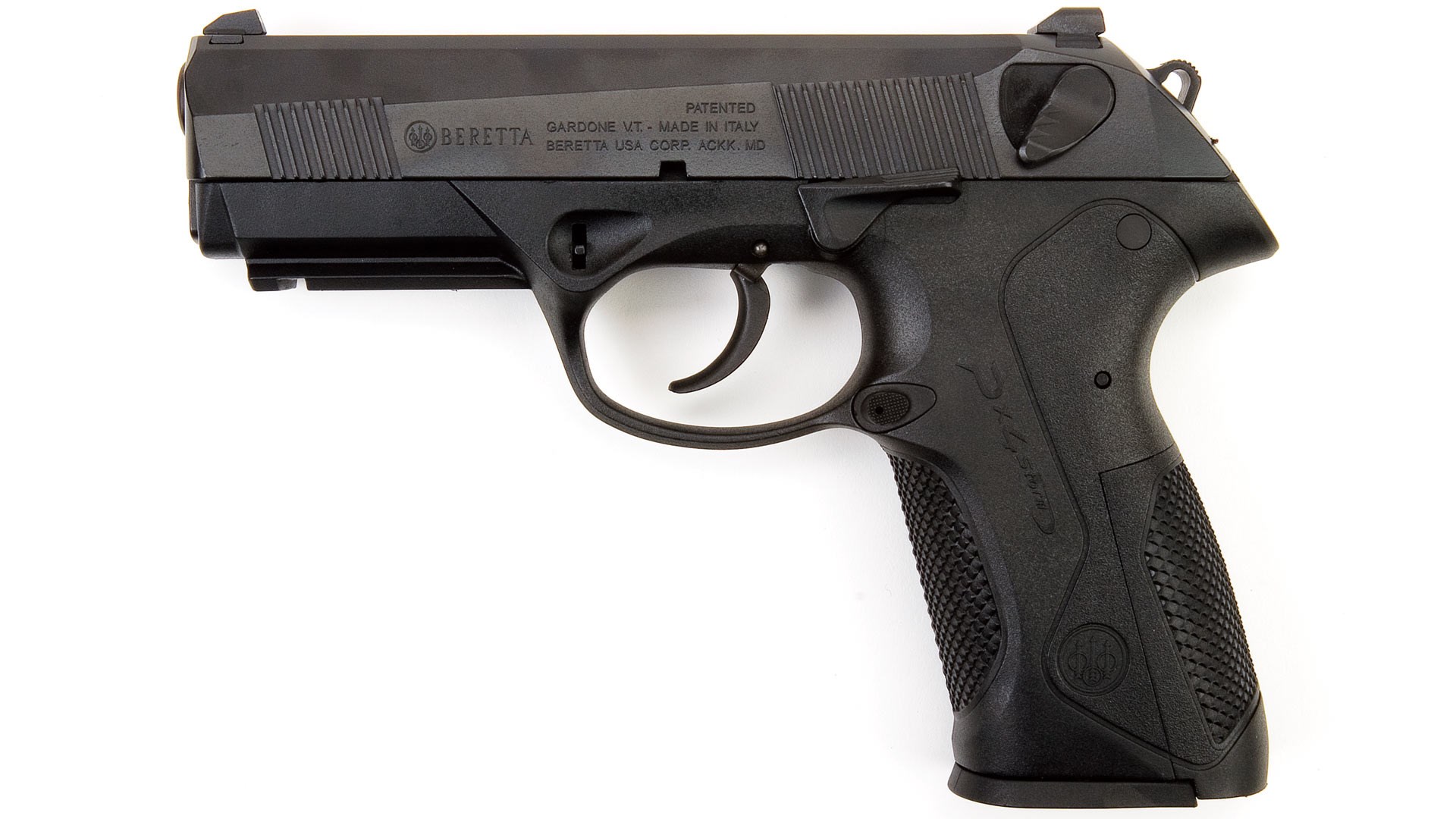
The Px4 pistol from Beretta is an all-new polymer-and-steel semi-automatic design with a generous magazine capacity (17 rounds in 9x19 mm) and the shooter’s choice of lockwork options.
The Px4 designation stands for “pistol times four” in recognition of the four chamberings in which it will eventually be offered: 9x19 mm, .40 S&W, and in the future, .357 Sig and .45 ACP. It is like many current service semi-autos in its use of modern manufacturing materials and methods. The pistol’s receiver is molded of an advanced thermoplastic material, while the slide and barrel are machined steel.
Shooters who have followed the trends in modern pistol development can identify several distinct design influences in the gun. For one thing, there was a definite effort on the part of Beretta engineers to build a gun that could be used by a wide majority of the population, in terms of size. They also wanted to use a single platform that could be adapted to individual preferences or department-mandated shooting technique. Finally, they wanted to offer a pistol that could be serviced efficiently in the field by Beretta-trained armorers.
The result is a versatile semi-automatic pistol weighing just 27.7 ozs. and measuring 7 9⁄16" long by 5½" high by 1 3⁄8" thick. The Px4 is chambered for potent pistol cartridges and needs a recoil-operated, locked-breech system to deal with them. This one is a rotary-barrel type, wherein the barrel is locked to the slide for the first bit of recoil, then unlocked by camming surfaces that rotate it, rather than dropping it, for the remainder of the recoil stroke. The Px4 is a pistol with advanced ergonomics in its design—features that afford subtle improvements for a combat handgunner.
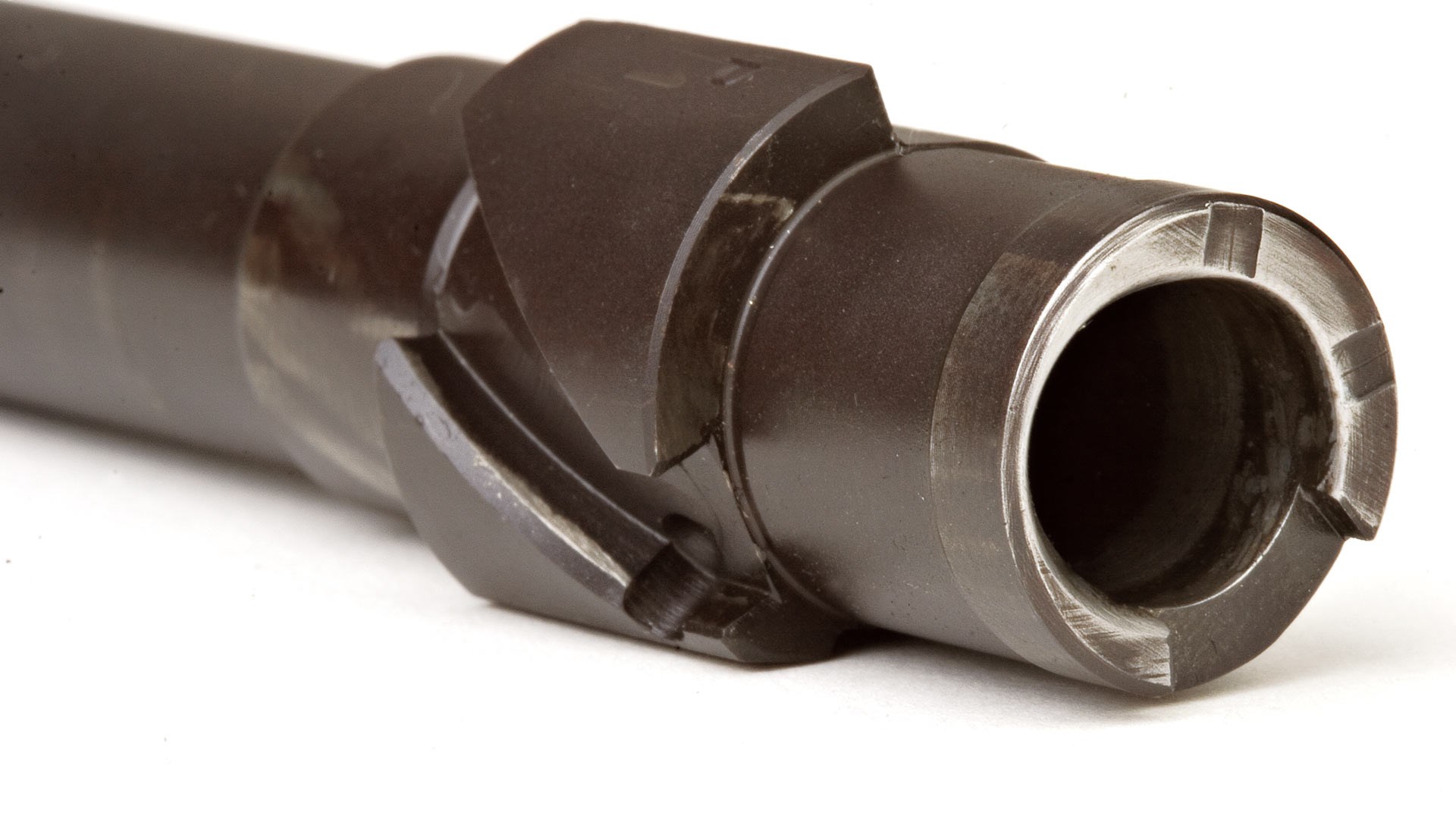
The barrel of the Px4 rotates to lock into battery with the slide. This is a highly workable system, but it does create a rather thick pistol that tends to torque in the shooter’s hand.
The current trend is toward a constant-action trigger system that offers the same trigger pull for every shot for repeatability. The Px4 accommodates that trend and adds three other trigger systems. They are called F, G, D and C series. The F-series pistols have essentially the same lockwork as is used on Beretta’s 92F pistol, which is also known as the M9 U.S. service pistol. This is a double-action/single-action system with a slide-mounted decocker/safety. Next is the G series that is also a double-action/single-action. The G models have a slide-mounted decocker lever with no manual safety function. Then, there is the D-model Beretta, a double-action-only (DAO). As a DAO, it cannot be cocked and, therefore, has no need for a decocker. Also, a DAO pistol has no real need for a manual safety because the system has the same inherent safety as found on a double-action revolver. Finally, at last summer’s seminar, we were told about, but not shown, a new C-model variant that has a constant-action trigger. This is a form of DAO that is shorter, lighter and easier to use than the D models.
My personal preference is the G model, which handles much like the Sig-Sauer series of pistols. There is a conveniently located decocker but no safety. I like the single-action trigger on the G models and can live with the fairly smooth double-action trigger on the first shot. The major point is simply that Beretta has provided for a lot of choices in the lockwork of the Px4 pistol.
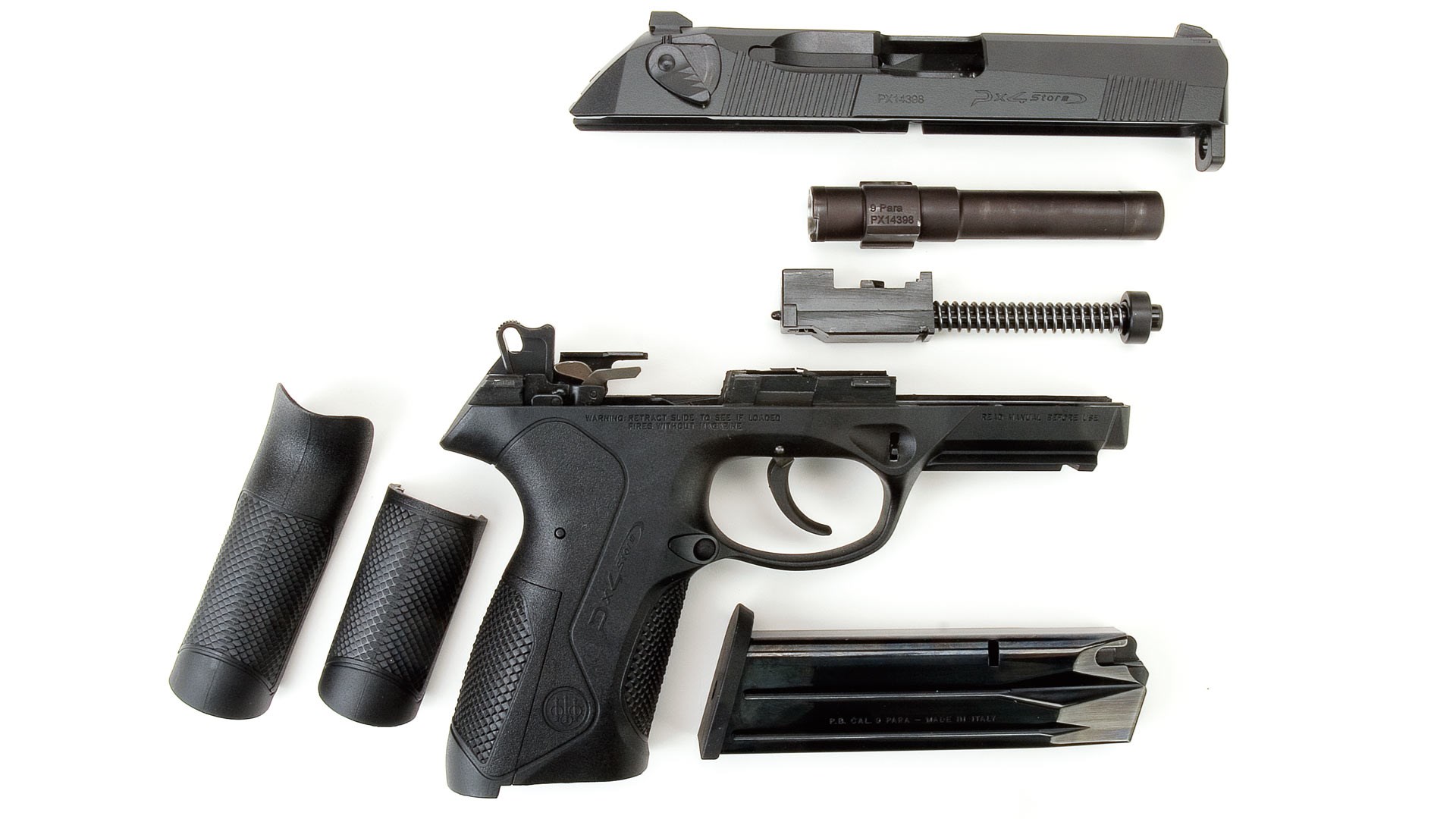
Px4 stands for “pistol times four” and that represents the four calibers for which the gun will eventually be chambered: 9x19 mm, .357 Sig, .40 S&W and .45 ACP. The first three will be built on the same general receiver.
By design, Beretta has also made it easy for a trained armorer to service this complex assortment of action options. For example, it is possible to make the F-model Px4 into a G model by substituting a different slide lever. Slides and receivers are the same. In the case of the D and C variations, which come with a different slide than the F and G pistols, a different hammer module is required. Interestingly enough, the hammer module in any Px4 pistol is similar to the ones found on exotic pistols like the fabled Sig P210 or the departed Star 28/30/31 series. The hammer, hammer strut, mainspring and several related parts are mounted on a plate that installs as a unit in the gun. This arrangement makes servicing the action much easier.
Even field-stripping is simple and requires no tools. First, remove the magazine and clear the pistol of ammunition. Then pull down on the two disassembly levers just above the trigger guard. This releases the slide and permits it to slide forward off the receiver. Now, turn the slide over and lift out the recoil spring and guide, as well as an unusual part called the central block. This part surrounds the recoil spring at the rear and provides the camming surface that turns the barrel in and out of battery. With these parts out of the way, the rotating barrel simply lifts out of the slide.
The sample pistol provided by Beretta was a 9x19 mm in the F configuration—a DA/SA with the decocker/safety lever on the slide. It is intended to be carried with a full 17-round magazine and one round in the chamber, hammer down and the safety in the down or safe position. Many police agencies choose to carry the gun with the safety off, relying on the double-action trigger for a measure of safety in handling. In my opinion, this is the way to go, since the upward flip of the safety lever to the fire position is awkward and usually requires the shooter to break his firing grip.
Prior to my range session with the gun, I made sure that I was familiar with its lockwork and general operation. With the noted exception, everything is well laid out and works with minimal effort.
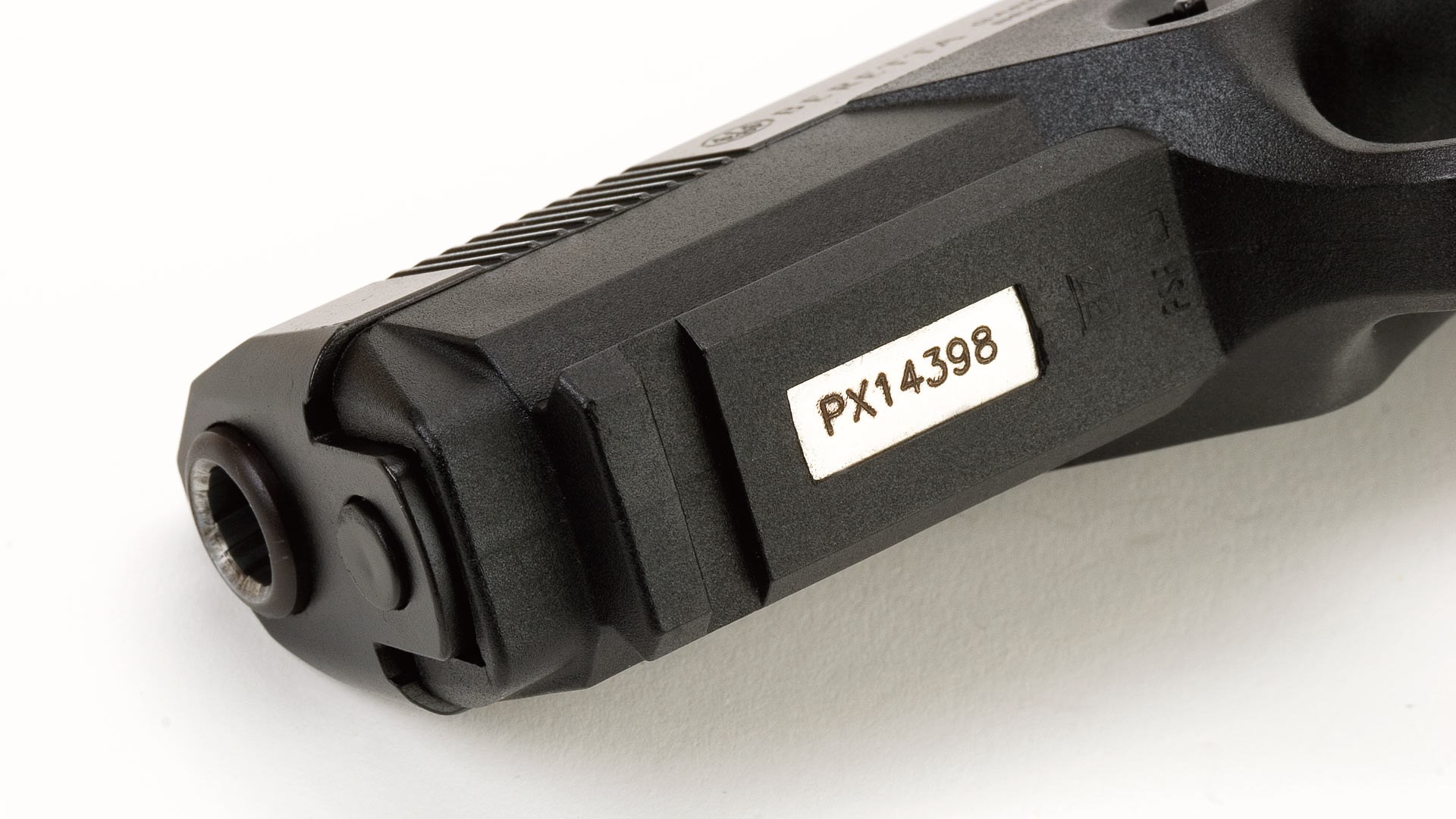
Like most polymer pistols, there is a non-deforming metal serial-number plate embedded in the pistol’s dust cover. Also note that the Px4 is like most modern pistols in that it has an accessory rail for lights and lasers.
If the Px4 is an easy gun to operate and shoot, that is in no small measure due to the great effort put into its ergonomics. Since the advent of the polymer receiver, pistol makers have had much greater freedom to control a gun’s shape. This has lead to modernistic pistols with features that make them much more comfortable to handle. Beretta in particular has used the design firm of Giugiaro, whose designs first appeared on the Cougar and Neos pistols, as well as the Cx4 Storm Carbine. The company’s style involves a lot of sweeping lines and curves that give the same impression as the latest Italian sports car. The Px4 has the same general style about it, although it is a little more restrained than the wild-looking Neos .22. There is far more here than just style. Most of the Px4 contours are very functional.
Take the slide, for example. As a matter of necessity (to give them a greater mass), today’s pistol slides are rather blocky and square. This creates a pistol that doesn’t point very well and one that may be a little difficult to re-holster. Take a look at the slide of the Px4. It has a pronounced bevel to the transitional surface that connects the sides to the top. It tapers toward the muzzle, creating a wedge-shaped effect that points well and holsters easily. Also, the frame has a number of bevels and radii on the forward edges, and the disassembly catches are nestled down in their own teardrop-shaped recesses above the trigger guard. The slide lock on the left side of the receiver above the rear edge of the trigger guard has an unusual wedge-shaped contour that looks like it never could get in the way.
One of the big knocks on the original Beretta 92F pistol was the shape and location of the ambidextrous slide-located safety/decocker levers. With the earlier Beretta, a shooter could hit these levers and put the gun on safe without realizing it. In the midst of a confrontation, this could be a problem.
The Px4 design effectively resolves this difficulty by moving the pivot point of the lever slightly and changing its shape. With this pistol, it is virtually impossible to make this mistake.
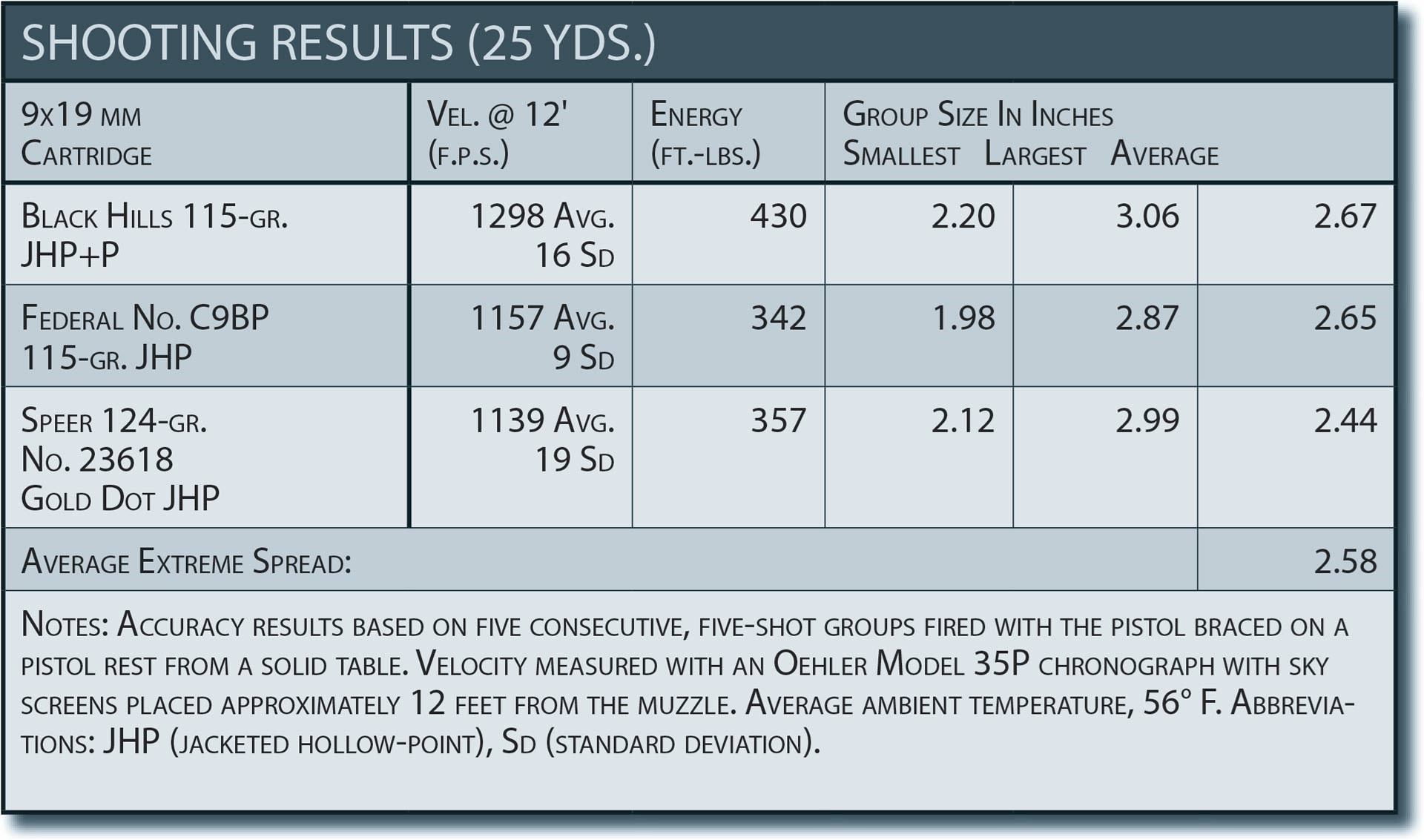
And while we are on the subject of clearing malfunctions, consider the worst type: a feedway malfunction or class III. In this one, you have to rip the magazine out of the gun after locking the slide back. To make it easy to get a grip on the magazine, the Px4 has a slight recess on each side of the grip at the edge of the magazine well. It’s just enough to permit the shooter to get a good grip and remove the jammed magazine from the pistol. Additionally, the pistol has front slide serrations as are popular now.
More excellent ergonomics come in three interchangeable magazine-release buttons. This feature enables the shooter to tailor the pistol to his particular needs. Human hands vary considerably, and a magazine release that stands a particular distance above the surrounding surface may not be ideal for the smaller or larger hands of other shooters. To provide a greater measure of customization, three interchangeable backstraps are available. The Px4 comes with the medium one, but the small and large backstraps are extra-cost options. Several of the current crop of modern pistols have this feature, and it may be the best thing that has happened to the pistol in 50 years. Particularly when every new gun is a high-capacity pistol with a wide magazine, the ability to tailor the gun to the hand is extremely important.
In the Beretta Px4, we have a pistol that is well designed for the majority of hands. The trigger pull in that first-shot, double-action mode is relatively smooth and short, and I found the single-action trigger pull to be excellent. Breaking at about 4 lbs., the single-action trigger is fairly light and as clean and crisp as it is possible to get on a mass-produced pistol.
It breaks cleanly, making the Px4 a very nice gun to work with in fast action-shooting exercises. Naturally, I fired single-action from the bench to derive the table of shooting results.
The accuracy is on a par with any of the modern 9x19 mm pistols in wide use today. I found one particular idiosyncrasy of the pistol that may be troublesome to some shooters. It centers on the recoil stroke—literally, what happens when you squeeze off a shot.
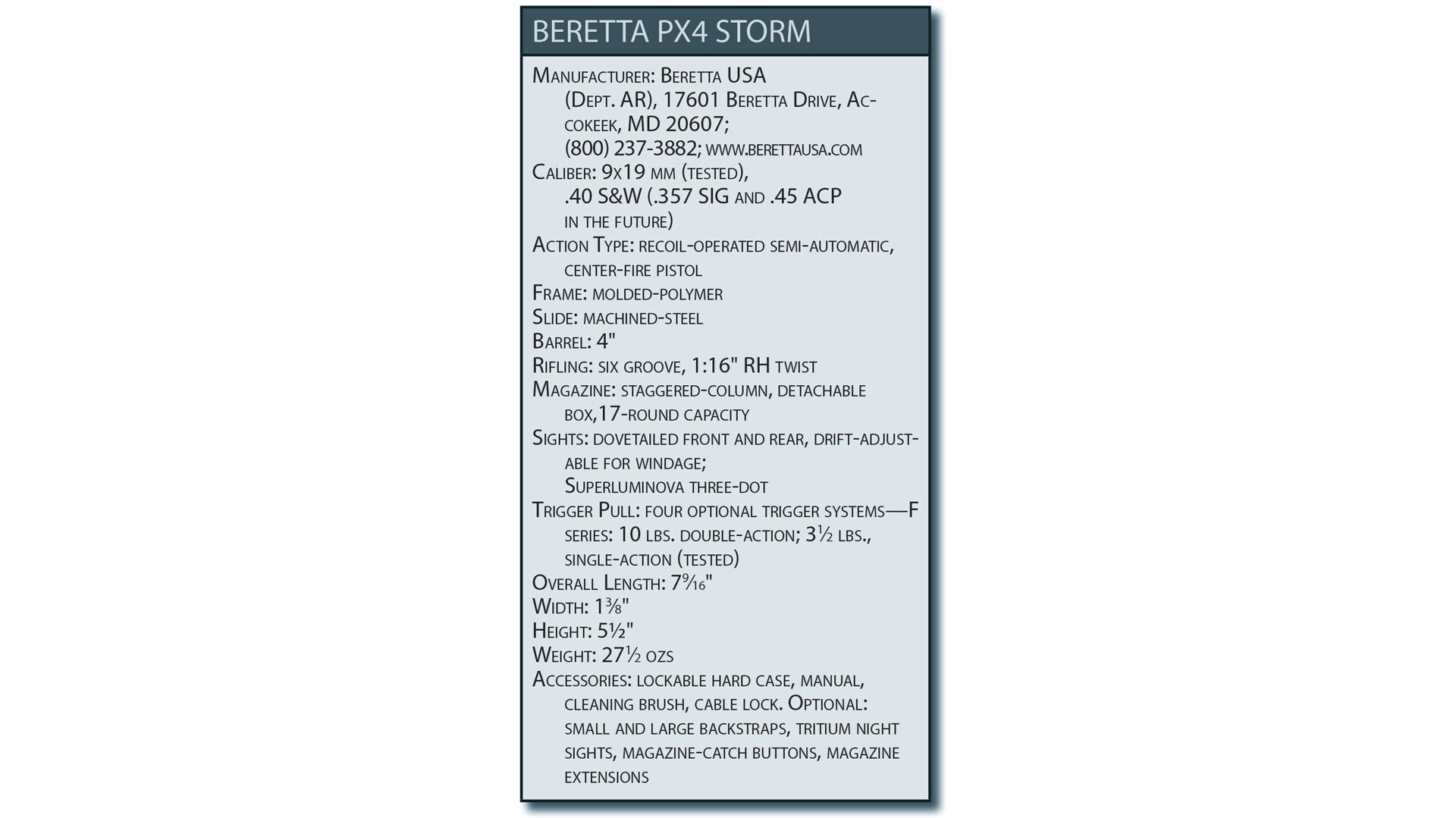
Since the breech-locking system on the gun is a rotary type, where the barrel rotates counter-clockwise out of engagement with the slide, the pistol has a tendency to torque in that direction. For a right-handed shooter, that means the barrel is turning away from the strength of his or her hand.
Shooting one-handed is a bit difficult, but in a strong Weaver stance, the second hand and a strong push-pull control make it possible to deliver fast pairs.
All things considered, I believe Beretta’s new service pistol is a great design that might replace the familiar Model 92/96 pistols in the line. When you also consider the availability of the Cx4 carbine in the same calibers and using the same magazines, you have a system with a strong appeal to civilian and law enforcement buyers.
At the Beretta seminar last summer, the Beretta folks were deliberately vague about the introduction of a .45 ACP Px4. I hope to see one of these guns soon. In these United States, the .45 still rules the roost, and such a gun would be a great addition to the catalog. As it is, the Px4 is a fine handgun that’s going to get its share of the attention, particularly in light of its modest price tag.






















